Shrubb, Cliff
Posted: Friday 05th June 2020
Cliff’s framebuilding experience started as a boy with Claud Butlers in about 1950 and continued through to building full-time for himself, working in between for several companies outside of the cycle-industry repairing and servicing timing clocks. In fact Mario Vaz told me he can remember working at Holdsworth’s many years ago when Cliff used to come and service their clocking-on clock.
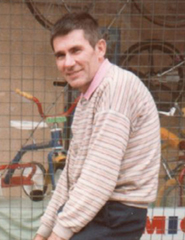
Cliff’s framebuilding experience started as a boy with Claud Butlers in about 1950 and continued through to building full-time for himself, working in between for several companies outside of the cycle-industry repairing and servicing timing clocks. In fact Mario Vaz told me he can remember working at Holdsworth’s many years ago when Cliff used to come and service their clocking-on clock.
I first met Cliff some 15 years ago when looking for someone to put a new bottom-bracket shell into my Donington frame. I was put in touch with Cliff by my local shop, Pearsons, where at the time he was working as their mechanic, and was amazed to find that he only lived round the corner from me so I could walk my frame round to him. He has been performing alterations and repairs for me ever since, as well as producing a spectacular fancy-lugged frame for me, which has become my favourite and most-ridden mount.
For a long time I had been searching for a “period looking” (or “retro” as it would probably be called today) frame. When I started cycling as a boy in the early 80’s I had always lusted after a 50s style frame with fancy-lugs like some of the older members of my CTC group were still riding. Hetchins had packed up just before I left university and started earning real money, and at 6ft 3in and requiring a minimum 25in frame I had no success in obtaining a genuine Hetchins or other elaborate frame secondhand at the jumbles. I had approached a variety of builders, including Longstaff and Dave Miller, who then owned Hetchins, none of whom were really willing to build quite whatI wanted.
So I turned to Cliff. He didn’t hesitate to produce a frame with a set of spectacular Len Phipps cut lugs, which look similar to some of the examples on the Len Phipps article page on this site (and incidently I notice similar to the Bob Jackson Legend series – did Len cut the lugs for these?). It also features curly rear stays but is built with Columbus TSX tubing that incorporates helical reinforcement ribs in the main-tubes, which have helped keep such a large frame relatively stiff and stable, instability and steering shimmy being a problem I have found with my “off-the-peg frames”. You can see some photos of it at:- http://www.flickr.com/photos/32100066@N08/sets/72157628178978407/
During his time Cliff has made several frames for some notable cycling personalities – Sean Yates won the National Pursuit 5000m championships on a Cliff Shrubb, this being one of the first low profile machines, with a hidden headset concealed within the head-tube. Tony Doyle won World Championship Pursuit on a Shrubb, and the Australian World Sprint Champion John Nicholson has ridden Cliff Shrubb frames, although Cliff isn’t sure if he ever won on one. Indeed Cliff recollects that one year Sean Yates and Tony Doyle came 1st and 2nd, meaning that both 1st and 2nd place were taken by Shrubb frames!
Cliff also built a frame for someone completing a Lands End–John O’Groats record and the late Leslie Crowther reporting on the story was featured on TV sitting on the bike.
One of Cliff’s most unusual commissions was the frame for Dave Le Grys’ unsuccessful attempt on the world pedal speed record in 1985. A motor-paced bicycle that featured two chainwheels in series to achieve the necessary high gearing to challenge the 150mph record. The frame was built from tandem tubing with the 2nd chainwheel half-way up the seat-tube braced to the rear-triangle with a 2nd set of chainstays to ensure rigidity of the rear-triangle under the high forces involved. It also has an eccentric tandem-style bottom bracket for adjusting chain-tension, it being a fixed wheel, and the tow-bar at the front incorporates a quick-release mechanism for letting go of the pacing car. Interestingly, at a time when many high-level racing cyclists were still using “tubs” it uses clincher Mavic Module E2 rims and wire-on tyres – possibly these were thought less likely to come off the rim in case of a puncture at high-speed.
There are several Youtube video clips of the bike paced by a specially prepared Tom Walkinshaw highly modified V8 Rover SD1 up the then unopened M42 available at
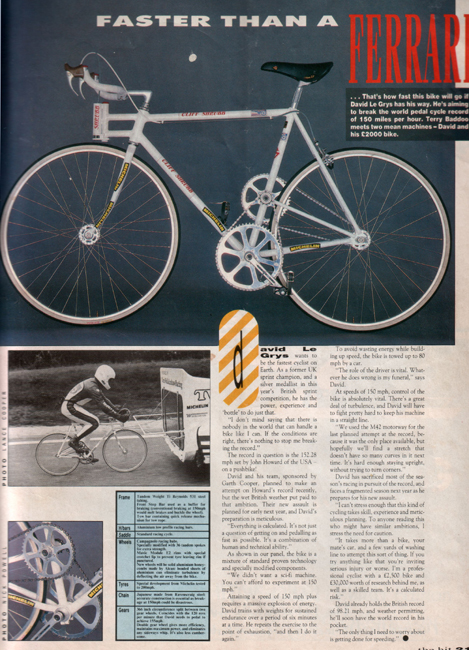
Cliff also built an unusual space-frame tandem to the design of Don Woodford. It utilises motor-bike hydraulic disc-brake, and very large diameter seat-tubes, with custom-seat-pins that also contain the pump and tools.
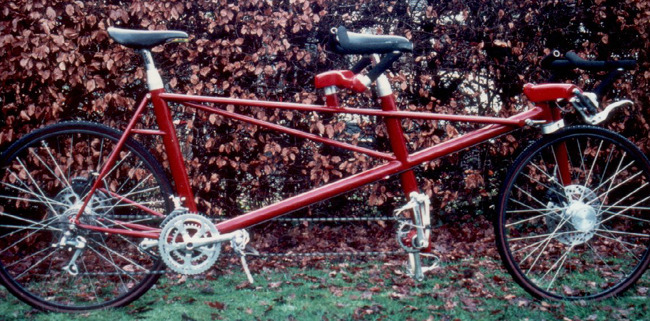
A lot of Cliff’s machines have been built for time trials and racing – he has produced quite a few unusual space-frame and low-profile time trial machines such as the two solos shown below.
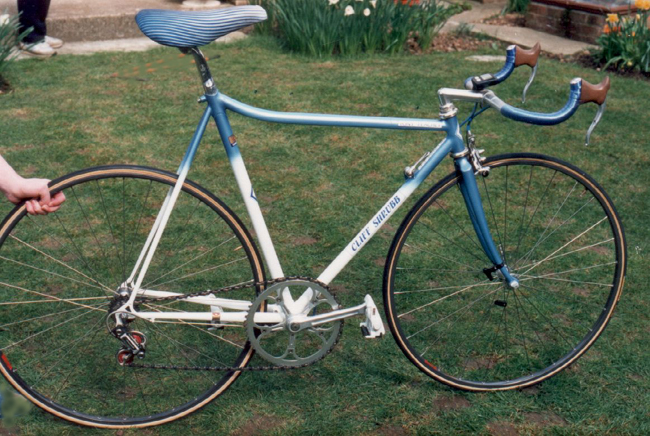
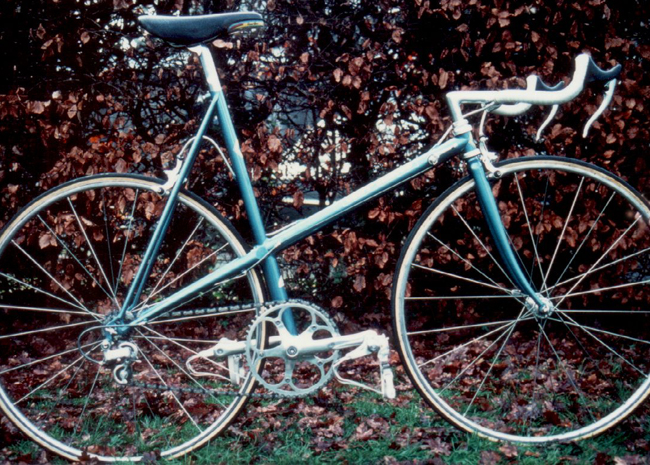
For the tandem rider he built an all Campagnolo Super Record racing tandem with the rear bars fixed under the top-tube, presumably to gain a a super-aerodynamic position for the stoker.
Most of Cliff’s photos are of later machines – does anyone have any pictures of his earlier frames?
Cliff is now retired and spends most of his time either out on his bike, driving his 2CV, and building the occasional frame or doing frame alterations and repairs. His life story is no less unusual than some of his frames……
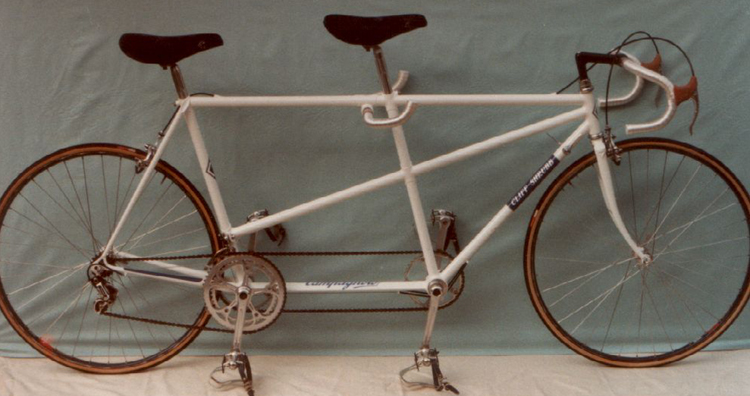
Cliff’s first real experience of cycling came at the age of about 10 when he and some friends went on a 4-day cycling expedition to Brighton from his home in South London, in the days when children were allowed to roam unsupervised without fear of abduction. His aunt lent them a tarpaulin to camp under and their first night was spent about 8 miles from what was actually Reigate, but which they had misheard as “Ramsgate”. They were told off by the farmer for camping in his field but a lady took pity on them and gave them some fresh eggs for breakfast. Their return journey night was spent camping beside the train tunnel vents at Pyecombe.
Cliff’s first job was in the drawing office at an engineering works called Palmers in Mitcham where he remembers the post-war austerity clearly as the less fortunate manual workers worked in the open under just a tin-roof with only a brazier burning for warmth.
He then progressed to Claud Butler’s works in Clapham in about 1950, aged about 16, where he was first put on frame-repairs. He later progressed to their production line. Here he remembers the tubes were cut and mitred on a milling machine and later blanked out with a press-type machine. A Danish chap then built the front diamond, someone else put in the chainstays and tacked in the seat-stays. It was Cliff’s job to braze-in fully the seat-stays and to put in the brake and chainstay bridges. Cliff remembers this as being a boom period for Claud Butler’s, as there would have been as many as 750 bicycles per order for export to the USA.
Cliff then went on his National Service in both the UK and Egypt, where he was in the Royal Electrical and Mechanical Engineers (REME), returning to Claud Butler’s for a few months before they went bust. Cliff says this was brought about not only by a sudden drop in demand for bicycles – termed “The Lambretta Era” but also the poor management of Claud Butler.
He then went to work for IBM for about 5 years, installing and repairing clocking-in machines and fire-alarm systems, until one day he and his mates got talking and decided they would drive to Australia – in two 2CVs !! (as you do ).
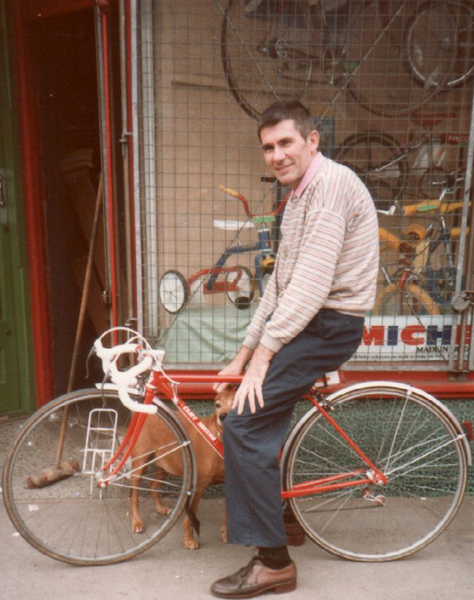
They got as far as Karachi in Pakistan, but as they had no visa they gave their cars to Customs to clear their carnets, and flew to Darwin. Here they got labouring jobs with United Uranium near Pine Creek, a uranium mine with two shops and pub, deep in the Northern Territory. Cliff claims that every frame he has built since comes with glowing testimonials! They subsequently drove to Brisbane in a Holden, where Cliff bought a 1928 Oakland, and his mate bought a Willys Whippet, which took them to Melbourne. Here Cliff worked for Cincinatti Time recorders, and Plessey Communications Systems of Australia, spending a year with each. Cliff remembers that he bought an Andre Bertin bike at the time for riding.
He returned home to the UK in about 1965, where he worked for Simplex Time recorders (no relation to the gear producing company) and then General Telephones Ltd for two to three days a week for a period of about 13 years, which is when he began frame-building for himself in his remaining time, renting for £2 a week a workshop in the garden of George Clare, the owner of Geoffrey Butlers in Croydon. Here he made frames for Butler’s and under his own name.
He moved into 81a Whitehorse Road, one of Allin’s old shops where “Cobbie” had made frames. A side-line of Allin’s had been to repair wind-up gramophones and Cliff remembers when he moved into 81a the workshop was full of old gramophone springs. Cliff thinks that Ching Allin’s dad had been in business with Freddie Grubb before the war and that Farmers Bank had gone bust and Grubb went off on his own leaving Allins with some debt (can anyone else add anything else to this ?)
When the lease on 81a ran out Cliff went to work in Pearsons of Sutton for about 13 years as their mechanic, building, altering and repairing frames from home in his own time before retiring.
If anyone has images and/or details of older frames or machines, please contact Webmaster, or David at:
dvines1971(at)btinternet.com
Posted: Friday 05th June 2020
Contents
- Overview
- Cliff
- Frames
- Dave Le Grys
- Youtube video clips of the bike paced by Tom Walkinshaw
- Magazine article
- Design of Don Woodford
- Unusual space-frame
- Time trials and racing
- Space frame time trial machine photos
- Tandem rider
- Tandem rider photo
- Cliff's first real experience of cycling
- Cliff sitting astride
- Cliff workshop
This article appears in the following categories.
Upcoming Events
Whether you are looking for a gentle social meet up, or a 100-mile ride browse the community’s upcoming events and plan your next weekend outing.
